ZOOM FX UNITS:
ZOOM 1201
This was the direct result of a search for a moddable machine that must have been sold in the hundreds of thousands of units, but now sits in a lot of peoples racks unused. Thats not to say there aren't some useful effects available on this unit, but these days many people will have replaced it with a computer, or just something better from the vast number of superb secondhand FX units selling for virtually nothing these days. As a result many Zoom units are now living in that twilight zone between not being good enough to be good, but not really being bad enough to be interesting. That wasn't the case in the late 90's though, when Zoom more or less ruled the budget FX unit world with the 1201, 1202 (see below), 1204, and later on the RFX1000 and RFX2000.

The 1201 was released in 1997 at just under £100, and was an instant hit. Virtually every home or budget studio in the late 90's either had one of these units or another cheap Zoom in the rack, probably alongside their Behringer Composer or Alesis 3630 compressors.
Its a stereo effects unit with a wide range of effects available. Theres not much in terms of editing and the reverbs are ok-ish, albeit the better end of ok-ish, but you didn't buy a 1201 for the quality of the reverbs or editing facilities. Probably the main attraction were the more interesting effects such as the Phaser, Tremolo/Pan, Auto Filter, Ring Modulator, LoFi EFX, Vocal distortion, Rotary speaker, and the main reason a lot of these units were bought, the Vocoder. Admittedly, the vocoder isn't exactly intelligible, but it was the late 90's and computers weren't really up to the job yet. Unless you had a Boss SE70, nobody had a vocoder!
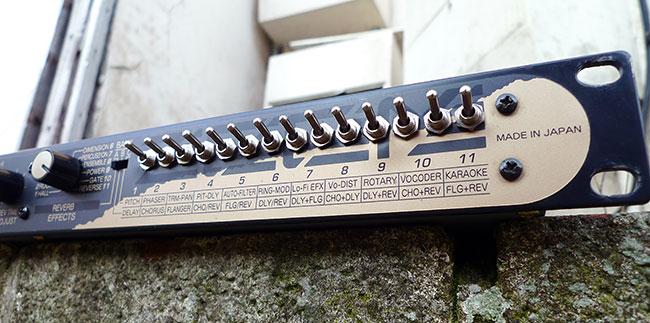
Our mods have added a reclocking knob, a 14 way RAM decimation switching matrix and most importantly, a power switch! Only someone who hasn't spent hours reaching around the back of racks, or trying to figure out exactly which power supply in the 4 way sockets is the one for the Zoom, would underestimate the usefulness of something as simple as a power switch!
The switching matrix operates on any effect that uses the onboard RAM. This includes the reverbs, delay, chorus, flanger, pitch shifting, LoFi, ring modulation etc. It also mangles any effect that has RAM based variations selectable with the 'character' knob. This includes the vocoder and vocal distortion that also have variations that include delay and reverb.
The switching matrix allows you to apply what sounds like various kinds of comb filters, pseudo ring modulation, bit crushing, distortion, and what can only be described as audio smearing™. Each switch has a certain effect variation that is usually associated with it, such as a certain frequency of sample chopping or distortion intensity, although its effect can be altered depending on which other switches are activated simultaneously. You have to activate more than one switch at a time for any new effect to be applied, but when two or more switches are activated their associated effects will combine to produce something new. Usually the original signal is not effected, but the effect signal will be, i.e. in a delay setting the original dry signal will pass through the unit unscathed, but the actual delay signal will be mangled beyond recognition.
The only drawback of this unit is an annoying amount of cyclical noise on certain effects and switching settings, and the fact that it often nearly gives you a heart attack when things get out of control very quickly, but with a little experience these issues can be avoided, assuming you want to avoid them.
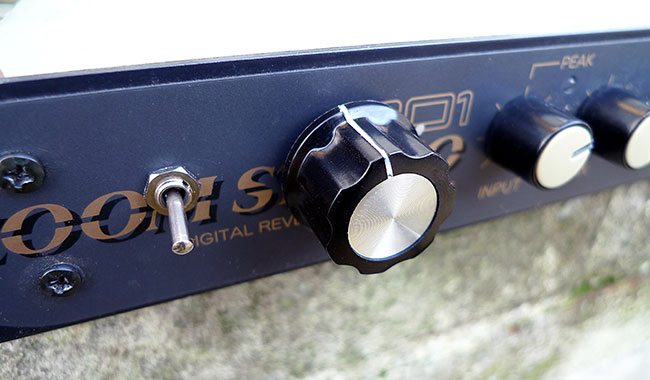
The reclocking knob sets the system clock speed of the RAM and the analogue to digital converters. This means it will extend the reverb and delay times to a degree way outside of what would normally be possible. Reverbs can be altered from short metallic ambiances to massive washes of disconnected sound just by turning the knob. Delay times are now extendable to a crunchy 15 seconds! The knob also changes the pitch shifting and ring modulation frequency, and appears to do very odd things to the vocoder and LoFi EFX.
As the reclocking knob also controls the clock rate of the converters, it also changes the sample rate of the incoming audio. At higher than normal clock settings the audio quality is actually better than the stock machine!
A small silver dot has been added to mark the point around the knob where the unit is set to its normal system operation frequency
Take a listen to the demos below to hear what kind of sounds this unit is now capable of producing. The first demo is the complete decimation of a Christina Aguilera track, and a D****y acapella. The second is some self generated noise using the flanger effect, and some vocoder action. The third demo is the unit destroying a couple of drum loops.
ZOOM 1202
The Zoom 1202 was released in 1995, two years before the 1201, but we're not going to question the wisdom of Zooms model numbering policy here! ;-)
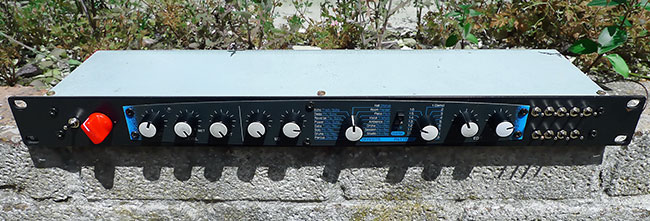
In many ways the 1202 can be considered the more sensible brother of the 1201. It doesn't have any of the bizarre stuff like the 1201's vocoder, Lo-Fi FX and ring modulator, but it does have a selection of more serious studio effects with some decent reverbs, delays, chorus and pitch shifting etc. Two benefits that are found on the1202 that are missing on the 1201, are low and high EQ knobs, and two edit knobs instead of just the one. These allow you to set delay times independently for the left and right channels, along with controlling the wider range of parallel effects that can be found on the 1202 i.e. a delay on the left channel and reverb on the right etc.
Essentially the 1202 will sit quietly in your rack just getting on with it, while the 1201 is busy pissing in the sink and vomiting on the curtains.
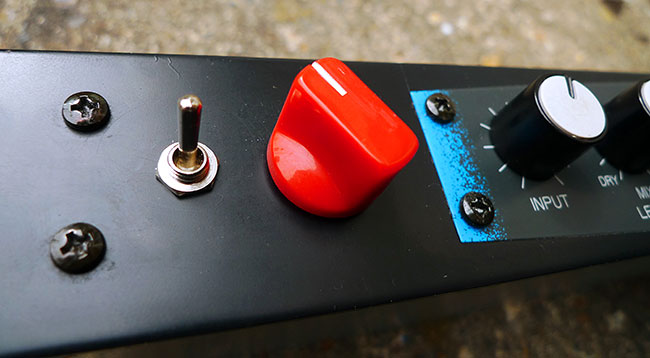
This more refined nature for the 1202 does come with a major benefit when the unit is circuit bent, in that with the addition of a reclocking knob the reverbs stay remarkably intact as you clock the unit down to slower system speeds. As the clock speed of the system slows, the reverbs become more and more granular until early reflections turn into creaking glacial lumps of noise and tails decay into a huge sea of sound. Unlike with many similar units, running the system at these low clock speeds doesn't introduce horrible squealing aliasing noise, or a floor of hissing white noise making the effect unusable. The reverbs produced may be unlike anything you've ever heard, but they are definitely a product of the sounds fed into the unit rather than being completely disconnected.

Alongside the reclocking knob we have also installed a 9 way RAM decimation switching matrix. This is almost identical to the 14 way matrix on the 1201 above, so we won't go into full details again, but the 1202 has one unexpected bonus.
Certain switch combinations on certain effects cause whatever is in the RAM at the time to be frozen and looped until the switches are released. This is especially effective on delay effects where echos can be grabbed and looped around while a sound is playing through the unit to create strange fills and breaks. This is shown to good effect on the percussion sounds and breakbeat in the 2nd demo below
Theres also the most exciting of all our mods............. a power switch!
ZOOM 1204
........and so on to the 1204
The 1204 was released in 1996, a year after the 1202, and a year before the 1201. In many ways it is exactly what that release schedule would suggest i.e. an upgraded 1202, with a small taste of some of the stranger effects that would be found on the 1201.
Like the 1202, the 1204 has various single effects, and a selection of dual settings, with 16 different variations of each effect. It also has a pair of parameter edit knobs and a pair of EQ knobs. As well as the standard reverbs, delays and modulation effects, the 1204 includes a SFX bank featuring a Vocoder (albeit a somewhat unintelligible one), vocal distortion, rotary speaker, and for some reason a selection of noise reduction settings.
On paper the 1204 should have been a massive hit as it had the huge bonus of being programmable rather than just being a preset machine, and the two effect edit knobs, the EQ knobs, and the mix control are all controllable via midi. The addition of a dedicated mic input on the front and PRAISE THE LORD!! a power button, was just icing on the cake.
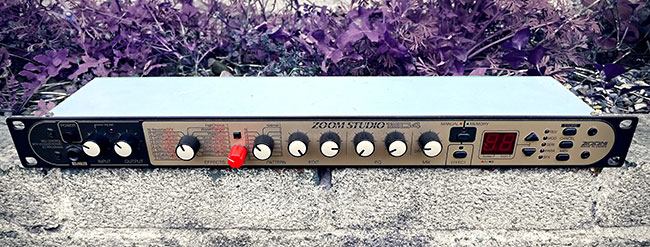
For some reason it seems that the 1204 didn't really capture peoples imagination like the 1201 did. If you wanted a decent budget reverb in the mid 90's, you probably bought a Lexicon Alex or Reflex, or even the cheaper Zoom 1202. If you wanted some stranger budget multi effects you bought a 1201.
It seems that people didn't really know what to do with the midi control, and we'd be willing to bet that most of Zoom's multi FX customer base were only really interested in quick and easy preset machines, rather than programmability. While you do still see a lot of 1204's around, they don't seem to be viewed with quite the nostalgia and fondness that people still have for the 1201.
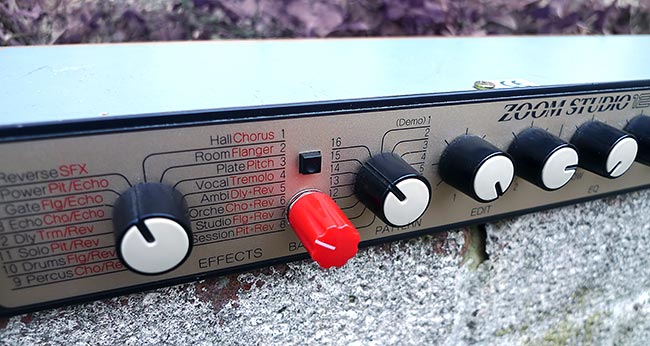
We only have one mod on the 1204, and thats the red reclocking knob to the right of the effect selection knob. It would in theory, be possible to add some kind of RAM decimation mods, but unfortunately in modding terms the major drawback of the extra programmability of the 1204, is the fact thats theres no available space behind the front panel. It was a tight squeeze just finding space for the reclocking knob! The only way to add any further mods would be to mount them on the top of the casing, or drill right through the effects names around the selection knob. We can't mount mods in an external rack case due to the length of the wiring causing interference problems.

The reclocking knob on its own is capable of creating some fairly extreme but usable effects, with results very similar to the reclocked reverb, and delay effects of the 1202, and the pitch shift, distortion and vocoder mangling on the 1201.
Check out the demo below to hear what kind of effects are possible. The vocal comes courtesy of a 1960's anti pornography educational film!






